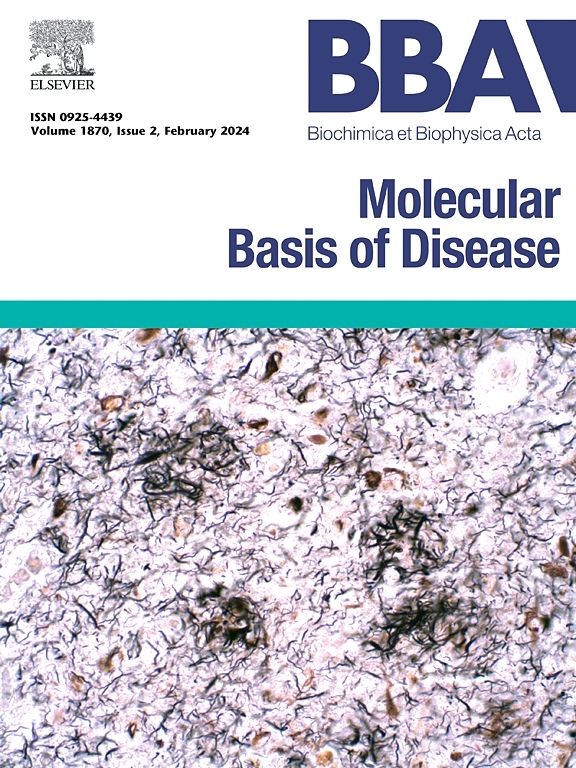缺氧时DRD5P2的缺失会减弱Rock2的降解,从而促进EMT和胃癌转移
IF 4.2
2区 生物学
Q2 BIOCHEMISTRY & MOLECULAR BIOLOGY
Biochimica et biophysica acta. Molecular basis of disease
Pub Date : 2025-04-23
DOI:10.1016/j.bbadis.2025.167858
引用次数: 0
摘要
背景转移是胃癌(GC)相关死亡的主要原因。然而,胃癌转移的分子机制尚不清楚。在这项研究中,我们重点研究了多巴胺受体5假基因2 (DRD5P2),一种新的长链非编码RNA在GC转移中的作用。方法采用实时荧光PCR (RT-PCR)和荧光原位杂交(FISH)检测GC中DRD5P2的表达。通过transwell侵袭和迁移实验检测DRD5P2在GC细胞中的作用。通过Western blot、共免疫沉淀(Co-IP)、染色质免疫沉淀(ChIP)和RNA免疫沉淀(RIP)分析研究DRD5P2/Rock2信号通路。通过ChIP和双荧光素酶报告基因检测,探讨体外缺氧对DRD5P2表达的调控机制。结果drd5p2在晚期胃癌中表达下调,与不良临床预后相关。功能增益和功能丧失研究表明,DRD5P2在体外抑制GC细胞的迁移、侵袭和上皮-间质转化(EMT),以及体内的腹膜传播。机制分析表明,DRD5P2与Rock2结合,募集E3泛素连接酶KAP1介导Rock2降解,从而抑制Ezrin/HRAS/ERK/CREB通路,最终减弱蜗牛介导的EMT和GC转移。此外,缺氧在GC细胞中以HIF-1α/ znf263依赖的方式抑制DRD5P2的转录。结论DRD5P2通过抑制Rock2/ERK/Snail信号通路在胃癌转移中发挥抑癌作用,缺氧条件下DRD5P2通过HIF-1α/ZNF263轴受到转录抑制。本文章由计算机程序翻译,如有差异,请以英文原文为准。

Loss of DRD5P2 in hypoxia attenuates Rock2 degradation to promote EMT and gastric cancer metastasis
Background
Metastasis is the leading cause of gastric cancer (GC)-related death. However, the molecular mechanisms underlying GC metastasis are not well understood. In this study, we focused on dopamine receptor 5 pseudogene 2 (DRD5P2), a novel long non-coding RNA, in GC metastasis.
Methods
Expression of DRD5P2 in GC was detected by real-time PCR (RT-PCR) and fluorescence in situ hybridization (FISH). The effect of DRD5P2 in GC cells was examined by transwell invasion and migration assays. The pathways underlying DRD5P2/Rock2 signaling were studied by Western blot, co-immunoprecipitation (Co-IP), chromatin immunoprecipitation (ChIP) and RNA immunoprecipitation (RIP) analysis. Regulatory mechanism between hypoxia and DRD5P2 expression was explored in vitro by ChIP and Dual-luciferase reporter assays.
Results
DRD5P2 expression is downregulated in advanced human GC and is associated with poor clinical outcomes. Gain- and loss-of-function studies showed that DRD5P2 inhibits GC cell migration, invasion, and epithelial-mesenchymal transition (EMT) in vitro, as well as peritoneal dissemination in vivo. Mechanistic analysis revealed that DRD5P2 binds with Rock2 and recruits the E3 ubiquitin ligase KAP1 to mediate Rock2 degradation, thus suppressing the Ezrin/HRAS/ERK/CREB pathway and ultimately attenuating Snail-mediated EMT and GC metastasis. Furthermore, DRD5P2 transcription is inhibited by hypoxia in a HIF-1α/ZNF263-dependent manner in GC cells.
Conclusions
DRD5P2 acts as a tumor suppressor in GC metastasis by suppressing Rock2/ERK/Snail signaling, and DRD5P2 is transcriptionally suppressed under hypoxia via the HIF-1α/ZNF263 axis.
求助全文
通过发布文献求助,成功后即可免费获取论文全文。
去求助
来源期刊
CiteScore
12.30
自引率
0.00%
发文量
218
审稿时长
32 days
期刊介绍:
BBA Molecular Basis of Disease addresses the biochemistry and molecular genetics of disease processes and models of human disease. This journal covers aspects of aging, cancer, metabolic-, neurological-, and immunological-based disease. Manuscripts focused on using animal models to elucidate biochemical and mechanistic insight in each of these conditions, are particularly encouraged. Manuscripts should emphasize the underlying mechanisms of disease pathways and provide novel contributions to the understanding and/or treatment of these disorders. Highly descriptive and method development submissions may be declined without full review. The submission of uninvited reviews to BBA - Molecular Basis of Disease is strongly discouraged, and any such uninvited review should be accompanied by a coverletter outlining the compelling reasons why the review should be considered.

 求助内容:
求助内容: 应助结果提醒方式:
应助结果提醒方式:


